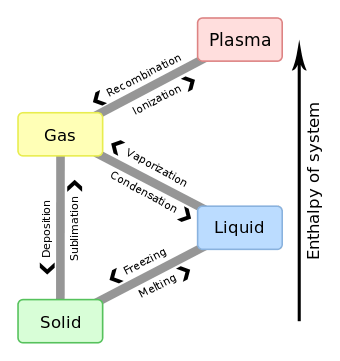String-net liquid
| Beyond the Standard Model |
|---|
 Simulated Large Hadron Collider CMS particle detector data depicting a Higgs boson produced by colliding protons decaying into hadron jets and electrons |
| Standard Model |
In condensed matter physics, a string-net is an extended object whose collective behavior has been proposed as a physical mechanism for topological order by Michael A. Levin and Xiao-Gang Wen. A particular string-net model may involve only closed loops; or networks of oriented, labeled strings obeying branching rules given by some gauge group; or still more general networks.[1]
Their model purports to show the derivation of photons, electrons, and U(1) gauge charge, small (relative to the planck mass) but nonzero masses, and suggestions that the leptons, quarks, and gluons, can be modeled in the same way. In other words, string-net condensation provides a unified origin for photons and electrons (or gauge bosons and fermions). It can be viewed as an origin of light and electron (or gauge interactions and Fermi statistics). However, their model does not account for the chiral coupling between the fermions and the SU(2) gauge bosons in the standard model.
For strings labeled by the positive integers, string-nets are the spin networks studied in loop quantum gravity. This has led to the proposal by Levin and Wen,[2] and Smolin, Markopoulou and Konopka[3] that loop quantum gravity's spin networks can give rise to the standard model of particle physics through this mechanism, along with fermi statistics and gauge interactions. To date, a rigorous derivation from LQG's spin networks to Levin and Wen's spin lattice has yet to be done, but the project to do so is called "quantum graphity", and in a more recent paper, Tomasz Konopka, Fotini Markopoulou, Simone Severini argued that there are some similarities to spin networks (but not necessarily an exact equivalence) that gives rise to U(1) gauge charge and electrons in the string net mechanism.[4]
Herbertsmithite may be an example of string-net matter.[5][6]
Examples
Z2 spin liquid
Z2 spin liquid obtained using slave-particle approach may be the first theoretical example of string-net liquid.[7][8]
The toric code
The toric code is a two dimensional spin lattice, that acts as a quantum error-correcting code. It is defined on a two dimensional lattice with toric boundary conditions with a spin-1/2 on each link. It can be shown that the ground state of the standard toric code Hamiltonian is an equal weight superposition of closed string states.[9] Such a ground state is an example of a string-net condensate[10] which has the same topological order as the Z2 spin liquid above.
References
- ↑ Levin, Michael A. & Xiao-Gang Wen (12 January 2005). "String-net condensation: A physical mechanism for topological phases". Physical Review B. 71 (045110): 21. arXiv:cond-mat/0404617
 . Bibcode:2005PhRvB..71d5110L. doi:10.1103/PhysRevB.71.045110.
. Bibcode:2005PhRvB..71d5110L. doi:10.1103/PhysRevB.71.045110. - ↑ Photons and electrons as emergent phenomena Michael Levin, Xiao-Gang Wen http://arxiv.org/abs/cond-mat/0407140 page 8 "loop quantum gravity appears to be a string net condensation..."
- ↑ Tomasz Konopka; Fotini Markopoulou; Lee Smolin (2006). "Quantum Graphity". arXiv:hep-th/0611197
 [hep-th].
[hep-th]. we argue, but do not prove, that loop quantum gravity's spin networks can reproduce Levin and Wen's string net condensation in quantum gravity...
- ↑ Quantum Graphity: a model of emergent locality http://arxiv.org/abs/0801.0861 page #19 "the excitation of the ground state...is expected to give rise to U(1) gauge charge, ...main difference between this model and the original model of Levin and Wen is that in the present case the background is dynamical, and has hexagonal rather than square plaquettes
- ↑ Bowles, Claire. "Have researchers found a new state of matter?". Eureka Alert. Retrieved 29 January 2012.
- ↑ Merali, Zeeya (2007-03-17). "The universe is a string-net liquid". New Scientist. 193 (2595): 8–9. doi:10.1016/s0262-4079(07)60640-x. Retrieved 29 January 2012.
- ↑ N. Read and Subir Sachdev, Large-N expansion for frustrated quantum antiferromagnets, Phys. Rev. Lett. 66 1773 (1991)
- ↑ Xiao-Gang Wen, Mean Field Theory of Spin Liquid States with Finite Energy Gaps and Topological Orders, Phys. Rev. B44, 2664 (1991).
- ↑ Kitaev, Alexei, Y.; Chris Laumann (2009). "Topological phases and quantum computation". arXiv:0904.2771
 .
. - ↑ Morimae, Tomoyuki (2012). "Quantum computational tensor network on string-net condensate". Physical Review A. 85: 062328. arXiv:1012.1000
 . Bibcode:2012PhRvA..85f2328M. doi:10.1103/PhysRevA.85.062328.
. Bibcode:2012PhRvA..85f2328M. doi:10.1103/PhysRevA.85.062328.
